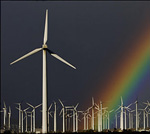
The states are taking the lead on capping greenhouse gas emissions–but that’s not the only way in which they’re leaving the federal government in the dust.
Lacking a federal renewable fuels standards, many states have passed legislation requiring utilities to produce a certain percentage of their electricity from carbon-free sources.
These laws are generating renewable energy business across the country. For example, California requires its utilities to produce 20 percent of their electricity from renewable energy sources by 2010. In response, state utilities like Sempra Energy plan to fund solar and wind projects to reach these goals.
California’s not alone. The Washington Post reports:
California is one of 25 states that have adopted laws that require electric utilities to use more renewable resources, and that has sent utilities scrambling to line up wind and solar projects across the country. Electric utilities that have long relied on coal, nuclear energy and natural gas to power their generating plants are buying into biomass projects from Minnesota to Virginia, solar plants in the deserts of California and Arizona, and wind farms from Maine to West Texas. […]
“The whole question has changed,” said Jeffery Wolfe, chief executive of GroSolar, a Vermont solar installation firm. The new standards “are forcing the utilities to do things they wouldn’t do.”
According to a study by the Lawrence Berkeley National Laboratory, state renewable-electricity standards will lead to the addition of 60 gigawatts of renewable capacity by 2025, equal to 4.7 percent of projected U.S. electricity generation, or about 40 or 50 new nuclear power plants.
Of course, a federal standard is more ideal because it would allow states to steer clear of renewable energy projects that are better suited elsewhere:
Some executives lament the lack of a national policy because the patchwork of state regulations pushes investment away from some of the most economical wind and solar projects. …
In California, [Neil Schmale, president of Sempra Energy] said, a federal standard might allow utilities to link up with projects outside the state, including wind power in Texas or Wyoming, where wind blows stronger and steadier.
But until the White House changes hands, it looks like a hodge-podge of state standards will have to do.
